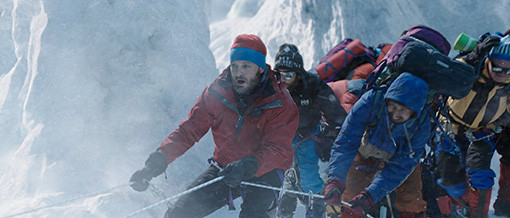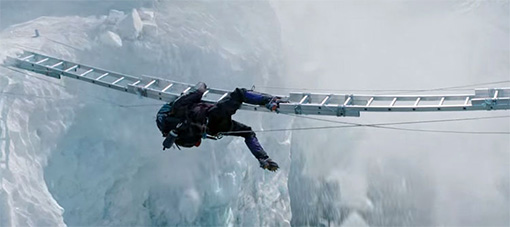"Well it's kind of a cautionary tale, this film. It's about the beginning of the
commercialisation of Everest. It's a story about how things can go – nature
is not a theme park... I think people should do whatever they want to do.
Climb a mountain, go into space. As long as they don't hurt anyone else. I
actually think a life is some- times better spent doing that than being buried in
a basement somewhere with a computer all your life and not taking any risks." |
Director Baltasar Komákur * |
I'm not a mountaineer or an adventurer of any kind. I have to admit that I'm closer to one of those poor souls Komákur mentions 'buried in a basement' except for the fact that I no longer have a basement. I'm a huge fan of Mother Nature though (how can anyone not be?) and walk as much as I sit down. It's hard for someone in my hyper-privileged position to fully understand how absolutely Nature can swat you like a fly. Even in the milder climes of the UK, stay out all night with too few layers of clothing and you run terrible risks of death or paralysis. And that's on our doorstep. What of those who crave testing the 'biggest and baddest' Mother of all at her very seat of power? If Everest the mountain is anything, it's where Nature reigns, a pointed throne thrust into the Heavens and if she's vacated that throne for a moment, it's the only window you have to test her and your own resolve. Once she sees you're still up there… Exposure to those elements, particularly if the weather is spectacularly bad (and in Nepal, snow storms can't get much worse) is a swift and painful death sentence. Forget the dwindling dearth of oxygen the higher you go, or the exhaustion that claims you after every oh-so-slow step. Get caught in a storm and like the unfortunates before you, think quickly on your dream of immortality. Frozen in place, your corpse will litter the route to the summit and until some brave soul has the compassion and ability to thaw you out, take you down and give you a warmer burial spot, you're there forever. And I'm not kidding. Everest and the route to the summit contain the remains of some two hundred and sixteen souls, visible in some cases as route markers. I can think of no better indicator of what risks you're taking than the bodies you pass, those of the dead who failed before you.

So given all that cheery information, why would anyone go and see Everest as it cannot be a spoiler to hint that Nature may claim one or two souls throughout the running time. The movie is based on a true story and is extremely faithful to the events if Wikipedia can be trusted. The filmmakers use the acceptable cliché of showing photos of the real people after the movie but again I ask, if you're in for such a grim slog, why subject yourself to it? There are several damn good, solid reasons; Komákur succeeds so well in realising his film, that he makes you feel every painful, cold step. When a frozen climber near death wills himself to move, his exposed blackened fingers set in rictus claws, the effort makes you wince with empathic alarm. The several loud cracks of a frozen body as it moves against everything around it trying to put it to ground are almost reasons enough to cover your ears. Secondly, the sound design is exemplary. Granted I saw it in conceivably its best venue outside of an IMAX theatre but the Dolby Atmos mix was clear (not all big movies are this intelligible and remember many characters speak through masks or thermal wear) and the sound design on the mountain was loud, ear-battering and piercingly harsh and perfect for ramping up the drama. The alarming sudden cuts to a quiet New Zealand bedroom or Texan living room after the intense howl of the storm are strangely attractive. Thirdly, in the same way that 3D made sense for a movie like Gravity, it's used well here too so you're shown every vertiginous drop with painful clarity. The 3D (a post production conversion) was just as 'flat level in front of other flat level and so on' like a 3D Viewmaster but it didn't detract even though you still feel you lose a stop of exposure with those bloody glasses on.
Fourth, and this was a real surprise, the performances were achingly real and not just those of the beleaguered climbers. The worrying wives, a way away were absolutely spot on dropping into their emotional abysses knowing that their husbands are in terrible trouble a world away and being able, in Jan's (Keira Knightley's) case, to speak to her husband Rob via walkie-talkie and phone while in the terrible grip of a storm. In fact I don't think I've seen Keira Knightley be so good except for perhaps A Dangerous Method in which she wasn't playing a normal person with the potential death of a spouse to deal with. Robin Wright excels in the role of the Texan wife waiting for news of her husband. The climbers all acquit themselves with honours. Although I didn't care for his character in Terminator Genysis (not sure I was supposed to), Jason Clarke's warm turn as expedition leader Rob Hall is convincing, heartfelt and you're never in a position of not feeling his dilemmas every step of the way. The more playful leader of a rival group, Scott, is played by a bearded Jake Gyllenhall. He plays the yin to Clarke's yang, ever more sure of himself, ever capable, up and down the mountain like a dervish. Prices are subsequently paid. With a small part but delivering a beautifully judged performance is Sam Worthington playing Guy, friends to both expedition leaders. Thrust into leading man stardom in Avatar like everyone thought Taylor Kitsch would be after John Carter, Worthington plays this small role to his strengths as the quiet, practical but ultimately helpless onlooker. Josh Brolin does a fine job as a Texan smartass doctor whose own health compromises his climbing ability. But the star of the show at base camp is the other mother of the team (aside from Mother Nature) Helen, played by the superb Emily Watson. Few actors can match Watson's seemingly effortless authenticity (if asked, I'd name Sally Hawkins as the only other actor I know who is incapable of thespian dishonesty). She's the beating heart of the film and the expedition and as such gets her own broken a few times.

Finally, the fifth reason I can conjure up, as a recommendation to seek out this film on the biggest screen you can find, is its total and utter believability. You accept that scenes shot on the summit of Everest are probably faked in some way (that's just a natural thought) but the suspension of disbelief is so total, the presentation of the action so immersive that there was not a single second that I was pulled up short imagining lots of Hollywood types prancing about on a green screen enveloped polystyrene soundstage. One of the key members of the crew is a good friend of mine and I had to ask him what was real and what wasn't because I had no clue watching the movie. It was that good. For the sake of accuracy, here's a breakdown of the filming, something that makes my eyes widen. I cannot believe how much I was fooled into believing I was watching the real thing. It's a staggering achievement. Scenes in Nepal were shot at the real location. There were four weeks filming in the Italian Dolomites getting storm material and snowy vistas. So far so real… The base camp exteriors were shot (drum roll) in the Cinecitta studios in Rome (respect, it looked damn real to me). Then filming the stunts, falls and closer shots and anything at the summit of the mountain were shot over seven weeks at (second drum roll) Pinewood's enormous 007 stage in the UK. I am humbled by this information and staggered at the level of craft that can now fool me, someone attuned, over almost 50 years of cinema-going, to spot a special effect with alarming speed. So congratulations to effects supervisor Dadi Einarsson and the exemplary work of (in alphabetical order as I have no idea who did what) Framestore, Important Looking Pirates (VFX Supervisor: Stefan Andersson), One Of Us, RVX and Union Visual Effects. Bravo.
Everest is grueling, seductive, breath-haltingly beautiful, surprisingly moving and full of the terrors of extreme weather and exposure. That it felt one hundred per cent real, looked one hundred per cent real and certainly wasn't, is filmmaking to be loudly applauded and celebrated.
Post Script
Just for completion's sake, there were three more fatalities on May 11th 1996, three members of the first Indian ascent of Everest but from the North side of the mountain. I'm sure their story is just as intriguing but that's for another film perhaps.
*http://www.wired.co.uk/news/archive/2015-09/15/everest-film-baltasar-kormakur-interview |